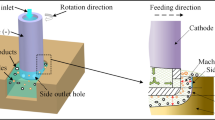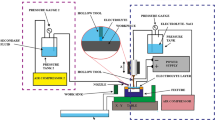Abstract
In microelectrodischarge machining (micro-EDM), dielectric plays an important role during machining operation. The machining characteristics are greatly influenced by the nature of dielectric used during micro-EDM machining. Present paper addresses the issues of micro-EDM utilizing different types of dielectrics such as kerosene, deionized water, boron carbide (B4C) powder suspended kerosene, and deionized water to explore the influence of these dielectrics on the performance criteria such as material removal rate (MRR), tool wear rate (TWR), overcut, diameteral variance at entry and exit hole and surface integrity during machining of titanium alloy (Ti-6Al-4V). The experimental results revealed that MRR and TWR are higher using deionized water than kerosene. Also, when suspended particles, i.e., boron carbide-mixed dielectrics are used, MRR is found to increase with deionized water, but TWR decreases with kerosene dielectric. Further analysis is carried out with the help of scanning electron microscope (SEM) micrographs, and it is found that the thickness of white layer is less on machined surface when deionized water is used as compared to kerosene. Also, a comparative study of machining time has been carried out for the four types of dielectrics at different machining parametric settings. Furthermore, the investigation on the machined surface integrity and wear on microtool tip have also been done in each type of the dielectrics with the help of SEM micrographs and optical photographs. Hence micro-EDM machining on Ti-6Al-4V work material with B4C-mixed dielectrics is performed in the investigation and reported the performance criteria of the process. It can be concluded from the research investigation that there is a great influence of mixing of boron carbide additive in deionized water dielectrics for enhancing machining performance characteristics in micro-EDM during microhole generation on Ti-6Al-4V alloy.
Similar content being viewed by others
References
Kagaya OY, Yada K (1986) Micro-electro discharge machining using water as a working fluid-1: microhole drilling. Precis Eng 8(3):157–162
Chow HM, Yan BH, Huang FY (1999) Micro slit machining using electric discharge machining with a modified rotary disk electrode (RDE). J Mater Process Technol 91:161–166
Luo YF (1997) The dependence of interspace discharge transitivity upon the gap debris in precision electro-discharge machining. J Mater Process Technol 68:127–131
Mohri N, Saito N, Higashi M (1991) A new process of finish machining on free surface by EDM methods. CIRP Ann 40(1):207–210
Narumiya H, Mohri N, Saito N, Otake H, Tsnekawa Y, Takawashi T, Kobayashi K (1989) EDM by powder suspended working fluid. In: 9th International Symposium for Electrode Machining, 5–8
Pradhan BB, Bhattacharyya B (2008) Improvement in microhole machining accuracy by polarity changing technique for micro-electrode discharge machining on Ti-6Al-4V. Proc Inst Mech Eng, B J Eng Manuf 222(2):163–173
Zhang QH, Du R, Zhang JH, Zhang Q (2006) An investigation of ultrasonic-assisted electrical discharge machining in gas. Int J Mach Tool Manuf 46(12–13):1582–1588
Jeswani ML (1981) Electrical discharge machining in distilled water. Wear 72:81–88
Chen SL, Yan BH, Huang FY (1999) Influence of kerosene and distilled water as dielectrics on the electric discharge machining characteristics of Ti-6Al-4V. J Mater Process Technol 87:107–111
Jeswani ML (1981) Effect of the addition of graphite powder to kerosene used as the dielectric fluid in electrical discharge machining. Wear 70:133–139
Chow HM, Yan BH, Huang FY, Hung JC (2000) Study of added powder in kerosene for the micro-slit machining of titanium alloy using electro-discharge machining. J Mater Process Technol 101:95–103
Chow HM, Yang LD, Lin CT, Chen YF (2008) The use of SiC powder in water as dielectric for micro-slit EDM machining. J Mater Process Technol 195:160–170
Kansal HK, Singh S, Kumar P (2007) Technology and research developments in powder mixed electric discharge machining (PMEDM). J Mater Process Technol 184:32–41
Bhattacharyya B, Gangopadhyay S, Sarkar BR (2007) Modelling and analysis of EDMed job surface integrity. J Mater Process Technol 189:169–177
Pradhan BB, Masanta M, Sarkar BR, Bhattacharyya B (2009) Investigation of electro-discharge micromachining of titanium super alloy. Int J Adv Manuf Technol 41:1094–1106
Ming QY, He LY (1995) Powder-suspension dielectric fluid for EDM. J Mater Process Technol 52:44–54
Tzeng YF, Lee CY (2001) Effects of powder characteristics on electrodischarge machining efficiency. Int J Adv Manuf Technol 17:586–592
Author information
Authors and Affiliations
Corresponding author
Rights and permissions
About this article
Cite this article
Kibria, G., Sarkar, B.R., Pradhan, B.B. et al. Comparative study of different dielectrics for micro-EDM performance during microhole machining of Ti-6Al-4V alloy. Int J Adv Manuf Technol 48, 557–570 (2010). https://doi.org/10.1007/s00170-009-2298-y
Received:
Accepted:
Published:
Issue Date:
DOI: https://doi.org/10.1007/s00170-009-2298-y




